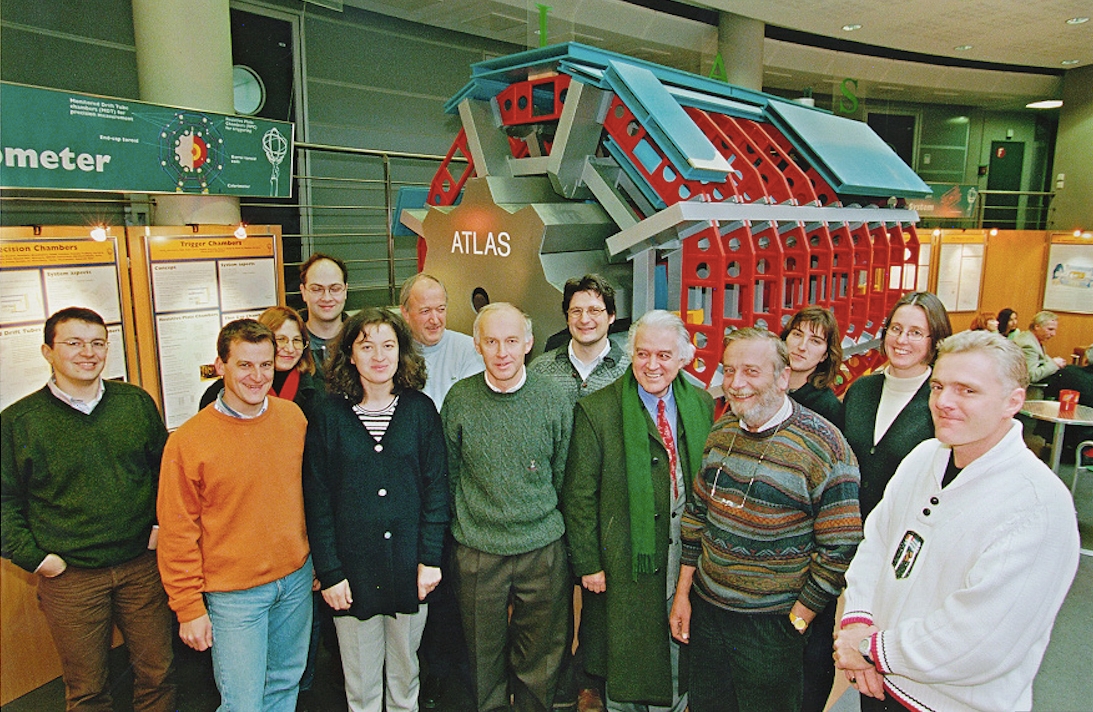Safety Matters in the PH Department
Mark Hatch joined CERN in 1984 as an engineer to work on the cooling and ventilating systems for the LEP project. From this time he became involved in safety related work: the design & installation of ventilation systems for smoke control of the experimental caverns, the pressurization systems for all the Lift and stair shafts. After spending some eight years in the accelerator sector, he joined what was to become the ATLAS experiment where he was part of the Technical coordination team working on the design and eventual installation of the experiment.

ATLAS Technical coordination team in 1998 in front of the ATLAS model in building 40. Mark, in the far right of the photo, joined ATLAS from the beginning since the Evian letter of intent for ASCOT.
“It was a different technical and cultural experience, but definitely an interesting one,” Mark says. “The work of an engineer is similar to the work of an artist; the journey is mostly enjoyable but once the work is complete it is done and then it is time to move on “The great reward that I enjoyed for spending many years in ATLAS was to see the build project from its beginning to the end,” he adds. After the completion of this project, Mark moved to the DT group, where he became more involved in safety issues. He has dealt with many conformity issues related to the mechanical workshops.
He is now the PH Departmental Safety Officer (DSO), collaborating closely with the Safety Engineering and Environment (SEE) Group of the Occupational Health & Safety and Environmental Protection (HSE) Unit. In general the HSE Unit elaborates the safety rules and inspectors examine buildings and installations to check on the conformity with the rules. It is the task of the Departments to implement these rules and of the DSO and his safety team to advise, communicate and reinforce any necessary actions.
In the beginning of each year, the DG makes a presentation to the enlarged Directorate of the annual safety objectives for the CERN community. This year's presentation included objectives on chemical hazards and evacuation exercises, while there is an ongoing objective from 2012 on the conformity of mechanical workshops.
In most buildings, there has never been an evacuation exercise before. This year, two evacuation exercises have already been organized for the PH Department; the first took place in building 188 – a multistory building occupied by many Users. The second exercise took place in a block of buildings, 11, 12, 13, and 14. Mark says: “We were worried that there might be an accident because many people use these buildings, which are between two very busy roads, close to the main entrance of CERN.” Two new assembly points were created, one at the front and one at the back of this block of buildings, in order to prevent people from crossing the road to get to the previous assembly point.
“We are satisfied with the results,” Mark adds, “There were no accidents and people behaved as they should in the case of alarm.” Careful planning and organization (thanks to Gilles Colin of the Fire Service and Niels Dupont, Deputy DSO) played a big part in this success. The Territorial Safety Officers (TSO’s) and the volunteer Emergency guides were most helpful during the exercise because some people tend to ignore an alarm, not immediately associating it with an emergency.
In addition, TSO’s are encouraged to take CERN first aid courses. According to Mark “at CERN, we are fortunate to have the Fire Service nearby, however the few minutes until they arrive can mean the difference between saving someone's life or not. The more people that are trained in first aid, the better.”
Safety in the PH Department
The PH Safety Office aims to improve the level of safety in the Department.
Recently, the safety procedure for the small experiments has been slightly modified. The Group Leaders In Matters Of Safety (GLIMOS) are responsible for the safety of their experiments. They are required to complete an “ISIEC” form; this is a checklist to identify potential hazards. The PH Safety Office grants safety clearance for the vast majority of the fixed target experiments and collaborates closely with the HSE Unit for other experiments (non-LHC) in order to offer assistance to the GLIMOS for their safety related needs.
One of the peculiarities of the PH Department is the very large users community that is attached to it. This has expanded incredibly over recent years. There are some 11.000 users and at any time there can be 3.000 or more on the CERN sites (greater than the number of CERN staff). They have a contract with their home institutes, however, while at CERN, they, like all people on the sites, need to comply with the many CERN safety rules that can be found on the HSE web site. It is quite a challenge to communicate and check if people are working to these rules.
Finally, Mark comments that “Safety is given as a high priority by the Director General, it should be an inherent quality of the work that we do at CERN”.
